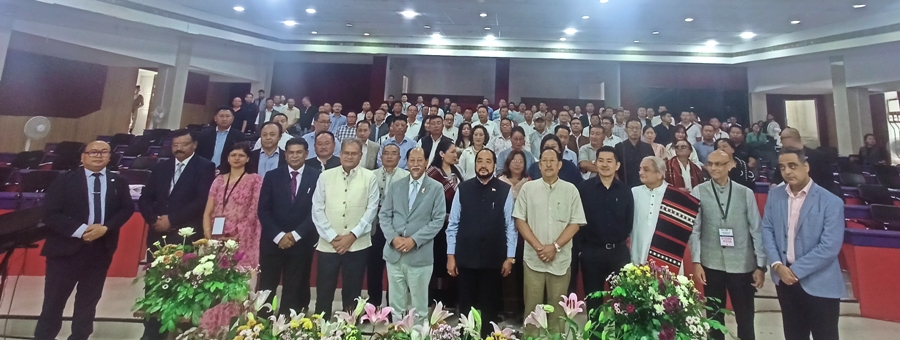Nagaland CM Neiphiu Rio mandates geo-technical reports for all infrastructure projects and calls for strict enforcement of building norms to prevent disasters.
Share
Calls for tighter regulation and disaster preparedness

KOHIMA — Nagaland Chief Minister Neiphiu Rio on Tuesday said that geo-technical investigations must be made a precondition for all construction approvals in the state.
“A geo-technical report is absolutely essential before any infrastructure development—homes, roads, bridges—in Nagaland due to its complex and unstable geology,” he said. Rio was addressing the inaugural session of a three-day training programme on Urban and Local Resilience, held at the Capital Convention Centre in Kohima.
He called on Urban Local Bodies (ULBs) and government departments to scrutinise all permit applications and make soil stability reports mandatory. Even simple interventions, such as clearing a drain, can protect lives and livelihoods, he added.
The training was organised by the Nagaland State Disaster Management Authority (NSDMA), Home Department, in collaboration with the UN Office for Disaster Risk Reduction (UNDRR), the International Institute of Security and Safety Management (IISSM), and the Department of Urban Development and Municipal Affairs.
‘Warriors’ of urban safety
Addressing elected representatives of municipal and town councils, Rio described councillors as the “warriors” of towns and wards.
“As elected guardians of every Naga town, you are now Nagaland’s first line of defence,” he said, reminding them that privilege comes with responsibility and public expectations.
He said that the training was organised to enhance their understanding of disaster risk reduction and management, and to build their capacity to safeguard communities.
“Your signatures on permits will decide whether structures collapse or communities thrive,” he said, calling for greater responsibility in issuing building permissions. He emphasised that their vigilance can prevent man-made disasters.
Rio urged councillors work in coordination with the Urban Development department and strictly enforce Building Bye-laws, stating that ULBs hold the key to ensuring safe construction practices.
He emphasised the need to tackle illegal encroachments along riverbanks and hillsides while underscoring that building permits must be treated as a covenant of safety, not a formality. Violations, he said, should invite consequences, including stop-work orders and demolition of unsafe structures.
The chief minister cited multiple recent disasters—including landslides below Kisama and a cloudburst at Pherima that led to loss of lives—as reminders of the state’s geological fragility. He noted that this year’s floods in Dimapur submerged markets and colonies, and also affected parts of Chümoukedima and Niuland.
“This cannot be our future,” Rio said, calling for resilient building designs in lowland areas like Dimapur, including raised plinths and stormwater channels, and Zone V earthquake standards in Kohima and other hill towns.
He warned against the dangers of unchecked construction in landslide-prone zones, floodplains and riverbanks, and called for urgent removal of encroachments.
Rio said the National Highway-29, which is part of Asian Highway 1 (AH1), is the most important road for the state but is in a pathetic condition. He noted that it was encouraging that visiting officials could witness the state during the monsoon, a season that reveals the region’s vulnerabilities.
On monsoon preparedness, risk mapping
Rio highlighted the critical role of ULBs in pre-monsoon planning and coordination with agencies like district DDMAs, fire services, PWD, PHED, and health departments. Drainage management is the top preventive priority, he said, listing steps such as desilting drains, clearing garbage and encroachments, repairing culverts, and addressing waterlogging.
He stressed the importance of stockpiling essentials such as sandbags, pumps, tarpaulins, and water purification tablets, while activating local disaster management plans and committees.
He also urged timely public alerts via announcements, SMS, social media, and local leaders, along with community awareness campaigns and hazard maps displayed in public areas.
On broader disaster risk reduction, Rio recommended landslide risk mapping in coordination with the NSDMA and Geology and Mining Department, and temporary measures like boulder netting where needed.
He acknowledged that enforcement against illegal construction in hazardous zones remains a challenge, but emphasised that it must be prioritised.
The training, he said, would help councillors become “true guardians of Naga lives” by understanding the principles of resilience and acting decisively against corrupt builders and unsafe practices.
He urged proper documentation of the training modules so that best practices can be shared across all ULBs.
Rio said the aim must be to make Nagaland a model for mountain resilience in India. “It is time that Nagaland’s urban towns rise up with wisdom on disaster risk reduction,” he said.
He acknowledged the constraints posed by the state’s terrain, limited resources, and the pressures of urbanisation, but said monsoon preparedness is an ongoing battle that requires coordinated efforts between ULBs, government departments, and communities.
Sanjaya Bhatia, Head of Office, UNDRR (Incheon), stressed that disaster risk reduction depends on informed decision-making by all stakeholders.
Z Nyusietho Nyuthe, Advisor for NSDMA and NRE, and Zhaleo Rio, Advisor for Urban Development and Municipal Affairs, also addressed the gathering.
Dr. Johnny Ruangmei, Joint CEO of NSDMA, provided an overview of the programme, while Home Commissioner Anoop Khinchi gave the welcome address.
Professor Santosh Kumar, CEO of IISSM, shared a note on departmental disaster management planning.
On the occasion, CM Rio also launched the initiative for preparing Departmental Disaster Management Plans for the state.